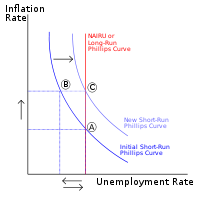Alban William Phillips
| Alban William Phillips |
|---|
| See also |
Alban William Phillips was born on 18 November 1914 in Te Rehunga, New Zealand, died 4 March 1975 in Auckland, New Zealand. He was a British economist, adherent to Keynesian Theory. He is most well known for constructing Phillips Curve showing relation between the unemployment rate and inflation rate.
A. W. Philips studied electrical engineering in New Zealand and in 1937 he immigrated to Great Britain. After the Second World War (1946-1949) he studied sociology at the London School of Economics (LSE), but soon switched his course to economics and within 11 years he became a professor of economics at the statistics department in LSE. 9 years later, in 1967, he left England and went to Australia to teach at Australian National University in Canberra. Then he went back to Auckland, New Zealand where he worked at the University of Auckland.
Economic achievements
In November 1958, during his work as a lecturer at LSE, he published his most well known article The Relation Between Unemployment and the Rate of Change on Money Wage Rates in the United Kingdom 1861-1957 in "Economica". He presented there in the graphic form (nowadays called Phillips Curve) the inverse relation between the unemployment rate and the inflation rate in an economy. Empirical correlation between these macroeconomic indicators was theoretically interpreted by Samuelson and Solow.
Phillips article was an impulse to begin a discussion whether to limit the rate of unemployment or rather aim to decrease rate of inflation, as it is impossible to gain both of these goals simultaneously. His theory was very popular during the 60's and was one of the principles of modern macroeconomics. Then it became a base for theoretical explanation of the causes of stagflation.
Interesting facts
It is very probable that had Phillips lived longer he would have received a Nobel Prize in Economic Sciences. He died relatively early, compared with other Nobel Prize laureates, at the age of 61.
Up until 1944 Phillips had never studied economics. He graduated with a diploma in electrical engineering and then studied sociology. He started his formal education in the field of economics in his 30's and only 10 years later became a professor. It is a great achievement and confirms huge economics talent of Alban William Phillips.
References
- Leeson, R. (1995). AWH Phillips: his machine and his curve. New Zealand Economic Papers, 29(2), 231-243.
- Leeson, R. (1997). AWH Phillips.
- Phillips, A. W. H. (1962). Employment, inflation and growth: an inaugural lecture. Bell.
- Phillips, A. W. H., & Leeson, R. (2000). AWH Phillips: Collected Works in Contemporary Perspective. Cambridge University Press.
- Phillips, A. W. H., & Bergstrom, A. R. (1978). Stability and inflation: a volume of essays to honour the memory of AWH Phillips. John Wiley & Sons.
- Ravier, A. O. (2012). Dynamic Monetary Theory and the Phillips Curve with a Positive Slope. Available at SSRN 2230461.
Author: Weronika Buczak
